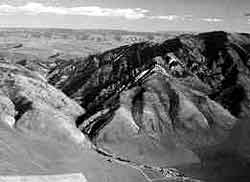|
Page
15
|

|
||
 |
||
| Raymond Canyon, south of Geneva, Idaho. View looks east across Sublette Ridge. The rocks in the canyon dip steeply eastward and include the Pennsylvanian Wells Formation at the mouth of the Canyon to the Jurassic Twin Creek Formation where the steep topography ends. Small mines near the mouth of the canyon are in the Permian Phosphoria Formation, (September, 1984). |
The
Thrust Belt of Southeastern Idaho
The geological
pioneers who surveyed southeast Idaho in the 1880s for the U.S. Geological Survey
recognized that the structure of the folded strata here resembled better known
thrust and fold belts like those in the Appalachians and the Alps. George R.
Mansfield, who worked extensively in southeast Idaho in the early part of the
20th century, mapped these folds and a large thrust fault, the Bannock thrust,
which he recognized in Montpelier and Georgetown Canyon, and west of Soda Springs
on the east flank of the Bear River Range. Better understanding of how sedimentary
formations deform when subjected to lateral compression, plus much data produced
as the result of petroleum exploration, have refined our conception of the thrust
faults of southeast Idaho.
In the southeast Idaho thrust belt we now recognize, from west to east, the Paris-Putnam, Meade, and Absaroka thrust faults, each of which forms the lower boundary for "thrust plates" or "sheets," which include the sedimentary rocks above the faults.
The sedimentary formations of the thrust belt were folded and broken much like a thin layer of wet cohesive snow ahead of a snow shovel. The results are geologic folds with amplitudes of 5,000 to 10,000 feet and thrust faults which move layers over one another with up to 50 miles of displacement. Thrust plates contain particular sets of sedimentary formations and economic mineral deposits, and are 10,000 to 20,000 feet thick. For example, all the phosphate mined in southeastern Idaho is from the Meade thrust plate, while the best prospects for oil production are in the Darby thrust plate, below the Absaroka thrust fault.